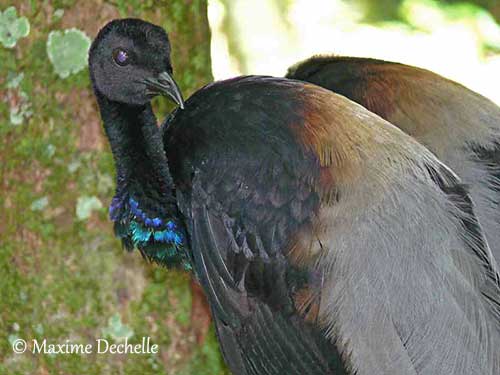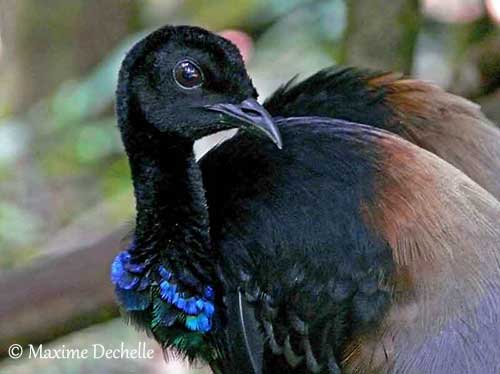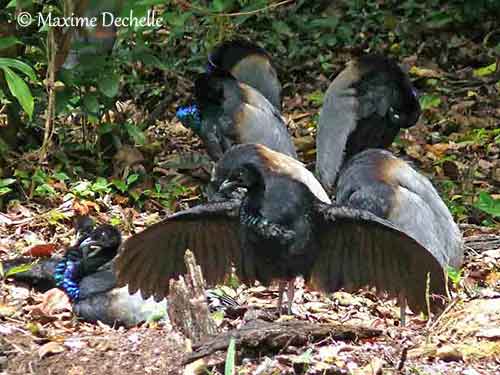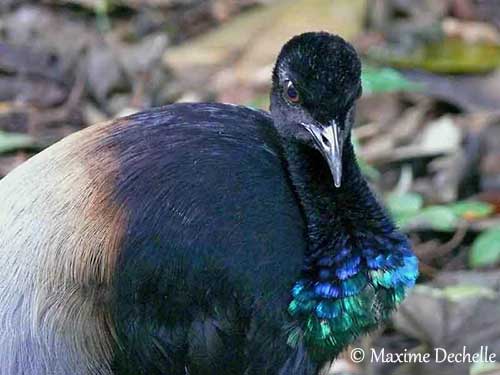
Grey-winged Trumpeter
Psophia crepitans
Gruiformes Order - Psophiidae Family
BIOMETRICS:
Length: 48-56 cm; Weight: 1000-1300 g
DESCRIPTION:
The Grey-winged Trumpeter is a terrestrial bird, with hunched back and long neck held against the breast.
Adult male has velvety black feathers on head, neck, upper back and underparts. We can see violet and green gloss on some feathers on lower fore neck. Inner wing feathers are grey, covering lower back and short tail. We can see pale buffy tinge on back, between black and grey plumage.
Head and neck are black, covered with very short feathers. They are very dense and have velvet appearance. Pointed bill is pale yellowish to pale-blue-grey. Eyes are dark brown. Legs and feet are bluish-grey.
Both sexes are similar, with male slightly larger than female.
VOICE: SOUNDS BY XENO-CANTO
Grey-winged Trumpeter is noisy, uttering various loud calls such as series of 6 to 8 low hummings “gumm” or “umm” notes. Series starts quickly for slowing and descending “ummumm-umm-umm-umm-umm-umm”. These sounds give the bird its name.
Other calls such as loud “jeek” or honking “tzak” are heard. When alarmed, it gives harsh grunts.
Grey-winged Trumpeter can be noisy and vocal at night, or when in group.
HABITAT:
Grey-winged Trumpeter lives in wet tropical forests. It feeds on the forest floor and it is often found deep in the forest where it hides. It can be found at up to 500 metres of elevation.
RANGE:
Grey-winged Trumpeter lives in the Amazonian Basin, in tropical South America. It is found in Guyana, French Guyana, from eastern Venezuela to western Ecuador, northern Peru, Brazil and north Amazon.
BEHAVIOUR:
Grey-winged Trumpeter is gregarious and often seen in groups of up to 20 birds. They forage on the forest floor, or rest together. This species is mainly territorial but they roost in trees and are often active by night.
Grey-winged Trumpeter is wary, but this species can become tame as pet. It usually “sounds the alarm” by loud trumpeting calls is there are disturbances by day or night. This bird is also a good snake hunter. Amazon Indians often keep them as pets.
Grey-winged Trumpeter is usually seen walking, searching for ripe fruits on the ground. When disturbed, it flies laboriously into branches. These birds are heavily hunted.
Courtship displays occur in clearings where Grey-winged Trumpeters gather in large groups, and perform elaborate and noisy crane-like dances. Birds strut, leap and sometimes somersault. Males often open briefly the wings and flap them 2 or 3 times, while rapidly bows forwards with head and neck towards ground. During these displays, birds walk, follow or circle each other, while flapping wings. These displays can be performed by both sexes, but mainly by males, and with greater intensity. Courtship feeding from male to female occurs before copulation.
Grey-winged Trumpeters are territorial and defend strongly their territories. When intruders enter the area, fights occur with kicking and pecking, until opponents leave the territory. These groups include usually a dominant female and three dominant males, and their young.
FLIGHT:
Grey-winged Trumpeter takes off by running on the ground, or if alarmed, it flies laboriously into trees at about ten metres above the ground or higher. It is weak flier and prefers to run.
REPRODUCTION:
Grey-winged Trumpeter can nest in small colonies. Nest is situated in hole in tree, at about 4 to 13 metres above the ground. Some plant materials can be added, such as twigs and leaves. But nest can also be a simple scrape on the ground.
Breeding season occurs during the rainy season, from December to June.
Dominant female will mate with the three dominant males.
Female lays 2 to 3 white eggs. Incubation lasts about 28 days, shared by all adults of the group. Young leave the nest relatively soon after hatching. They are highly precocial, but their growing is slow. They need about 50 days to reach half weight of the adults. They have brown and black stripes in plumage as camouflage. They are fed by adults of the group during several weeks. They roost close to the ground before to fly, and are often preyed upon by snakes.
DIET:
Grey-winged Trumpeter feeds mainly on ripe fruits taken on forest floor or in small plants. They prefer soft fruits with thin skins. This species also consumes large numbers of insects such as beetles, ants and termites. Occasionally, they can eat small snakes.
PROTECTION / THREATS / STATUS:
Grey-winged Trumpeter is not an endangered species, but it suffers heavy hunting. Destruction of the habitat by construction of roads through the forests is an important threat for the species. Grey-winged Trumpeters are kept as pets in several parts of the range.
Fr: Agami trompette
All : Grauflügel-Trompetervogel
Esp : Trompetero Aligrís
Ital : Psofia dalle ali grigie
Nd : Trompetvogel
Russe : Обыкновенный трубач
Photographs by Maxime Dechelle
His website: LEPAPARRAZO
Text by Nicole Bouglouan
Sources:
HANDBOOK OF THE BIRDS OF THE WORLD Volume 3 by Josep del Hoyo-Andrew Elliott-Jordi Sargatal - Lynx Edicions, 1996, 821 pages - ISBN: 8487334202
A GUIDE TO THE BIRDS OF COLOMBIA by Steven L. Hilty and William L. Brown
Princeton University Press – ISBN 069108372X
Birds in Suriname, South America (Jan Hein Ribot)
CREAGUS@Monterey Bay (Don Roberson)
Wikipedia (Wikipedia, The Free Encyclopedia)



